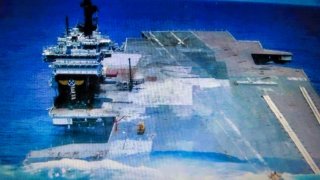The U.S. Navy Failed for 4 Weeks to Sink Its Own Aircraft Carrier and Got Desperate
The USS America (CVA/CV-66), a Kitty Hawk-class aircraft carrier, was sunk in 2005 after weeks of controlled explosions as part of a live-fire test to study how a large warship would withstand attacks.
What You Need to Know: The USS America (CVA/CV-66), a Kitty Hawk-class aircraft carrier, was sunk in 2005 after weeks of controlled explosions as part of a live-fire test to study how a large warship would withstand attacks.

-Initially commissioned in 1965, the America served for three decades, participating in the Vietnam War and other key missions before being decommissioned. Despite her decommissioning, the Navy used her one final time to gather data for future carrier designs.
-Her sinking proved difficult due to her double-layered hull and advanced compartmentalization, making her a formidable vessel even in retirement.
In 2005, a U.S. Navy aircraft carrier sunk for the first time since the Second World War. USS America sunk 17,000 feet below the floor of the Atlantic Ocean following weeks of controlled explosions on May 14th of that year. When the Kitty Hawk-class carrier was decommissioned almost one decade earlier, the Navy decided to conduct a study involving how a colossal ship would respond to explosions on board instead of simply relegating the vessel to retirement. The service would soon discover that sinking a U.S. aircraft carrier is easier said than done.
The history of USS America
USS America (CVA/CV-66) was one of three Kitty Hawk-class supercarriers designed for the Navy in the 1960’s. Built to be more capable than their Forrestal-class predecessors, Kitty Hawk, Constellation and America sported more advanced technologies. They were the first class of supercarriers to feature deck-edge elevators and angled decks in addition to high tonnage. The Kitty Hawk ships were meant to complement the Forrestals and embody a moderate improvement.
Each ship in this class was longer overall than previous carriers, with more practical elevator placements. A fourth Kitty Hawk carrier was also planned; however, USS John F Kennedy became so heavily modified that she was considered her own carrier class.
Introducing USS America
USS America was laid down in 1961 at Newport News, Virginia, by the Newport News Shipbuilding and Dry Dock Corporation. By 1965, she conducted her first catapult launch with a Douglas A-C4 Skyhawk. The same year, America sailed for her first deployment to the Mediterranean. She later participated in a simulated conventional warfare wargame with Frank before returning to Naval Station Norfolk. America was soon used to conduct flight qualifications for the F-4 Phantom, F-8 Crusader, and A-4 Skyhawk aircraft.
In her next deployment, America sailed again to the Mediterranean as a crisis in the Middle East was unfolding. When the technical research ship Liberty was attacked by Israeli torpedo boats and fighters in 1967, America was the first to respond, launching Phantom interceptors to ward off any potential attack against task force units. After it became clear that the Liberty attack was accidental and not an act of war, America was used to house the injured sailors from Liberty.
During the Vietnam War, America would make three deployments to the frontlines. In her first stint stationed on “Yankee Station,” America’s aircraft bombarded roads, trucks and other infrastructure to impede the flow of men and war materials to the south. America would later deploy in the Gulf of Tonkin and Subic Bay.
The post-service lives of the Kitty Hawk ships:
For decades, the Kitty Hawks served the Navy honorably. USS Kitty Hawk was overhauled in the late 1980s as part of the Service Life Extension Program for $785 million. Eventually, Constellation was overhauled under SLEP for an even more significant dollar amount. Kennedy later received a $491 million infusion to extend her service life.
However, the ship was not upgraded under the same SLEP program as her sister ships. USS America’s fate was quite different. Since America possessed such a strong track record at sea, the service decided to make the carrier useful one last time upon her retirement.
As then-Vice Chief of Naval Operations Adm. John Natham explained, “America will make one final and vital contribution to our national defense, this time as a live-fire test and evaluation platform. America's legacy will serve as a footprint in the design of future carriers — ships that will protect the sons, daughters, grandchildren and great-grandchildren of America veterans.”

The sinking of USS America: She Would Not Go Down
As another expert explained for the Aviation Geek Club, sinking the vessel was a challenging ordeal and almost looked a little desperate. “It took four weeks and they ended up having to scuttle her from on board due to her not sinking. She is not only far larger than WWII battleships, but she is also a lot tougher. While she does not have the heavy armor the battleships of yore had, she does have a double layered hull, meaning weapons have to push through alternating layers of steel and empty pockets to reach her internals. On top of that, her internal compartmentalization was far better than that of battleships. She is so large, there are so many more rooms that must be filled in order to make her sink than that of a battleship.”
After serving in the Navy for three decades, USS Americas remains at the bottom of the sea, somewhere between South Carolina and Bermuda.
About the Author: Maya Carlin
Maya Carlin, National Security Writer with The National Interest, is an analyst with the Center for Security Policy and a former Anna Sobol Levy Fellow at IDC Herzliya in Israel. She has by-lines in many publications, including The National Interest, Jerusalem Post, and Times of Israel. You can follow her on Twitter: @MayaCarlin.
All images are Creative Commons or Shutterstock.
From the Vault
Russia Freaked Out: Why the U.S. Navy 'Unretired' the Iowa-Class Battleships
Battleship vs. Battlecruiser: Iowa-Class vs. Russia's Kirov-Class (Who Wins?)


